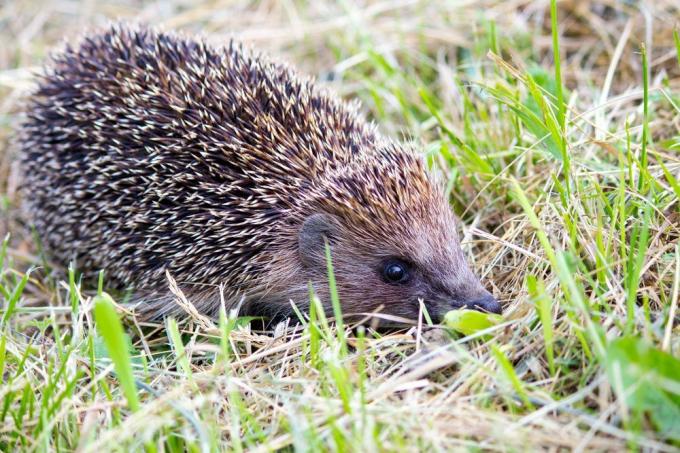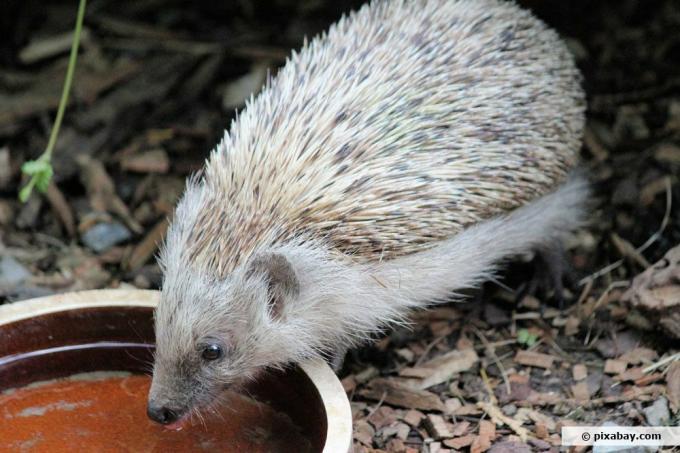
table of contents
- Feed the hedgehog
- When do hedgehogs need help?
- Misunderstood help
- Time for feeding
- The right hedgehog food
- Prevent malnutrition
- You shouldn't feed that
- To drink
- hygiene
Many wild animals have found a new habitat in human settlement areas, including the hedgehog. The prickly mammals are incredibly adaptable. In the wild, these cute animals can usually look after themselves very well. Feeding the hedgehogs is therefore not necessary, it can even harm them. Hedgehogs are not endangered species, but in some cases they can use a little help.
Feed the hedgehog
Hedgehogs (Erinaceidae) belong to the mammals that are found in 24 different species worldwide. We are almost exclusively home to brown-breasted hedgehogs (Erinaceus europaeus). The northern white-breasted hedgehogs (Erinaceus roumanicus), which can occasionally be found in the eastern fringes of Germany, are rarer. Hedgehogs are loner and usually roam large territories in search of food. As a typical cultural follower, however, they can also be found more and more frequently in house gardens, even in the city parks of large cities. The animals have a very wide range of food, but they are neither vegetarians nor omnivores. On their menu are:
- Woodlice
- Locusts
- Insects and their larvae
- Beetle
- Mealworms
- Annelids
- Snails
- be crazy
- Butterflies and moths as well as their larvae and caterpillars
- Millipede
- Bird eggs
- Frogs or small snakes
- occasionally small mammals
- rarely carrion

The small mammal does not need any food over the winter. He feeds on his fat reserves while he is in the cold season Hibernation spends.
When do hedgehogs need help?
The animals usually find sufficient food in the wild. In a varied living space with bushes, hedges and meadows, your table is always richly set. However, there are times when the animals may need support.
Spring (March to April)
When the first warm rays of sun hit the garden floor in spring, the hedgehog wakes up from its long hibernation. As a rule, older, males are a few weeks earlier than young animals and females. In order to regain their strength, they now need a lot to eat. If spring is mild, you can easily find it in your surroundings. If the temperatures drop again or if the food supply is still unsatisfactory, many of the animals crawl back into their winter quarters.
Autumn (October to November)
Food can be scarce even in autumn. During this time, however, it is very important that the animals get enough Winter fat otherwise they will not survive the cold months. Above all are affected Damswho have lost a great deal of energy in giving birth and raising their young. Finally, young animals look for a comfortable hiding place for the winter. They need a little more time than adult animals to gain sufficient weight to hibernate.
In both periods it may be necessary to feed the hedgehogs.
tip: Bring severely weakened or injured animals to a veterinarian or a wildlife sanctuary immediately!
Misunderstood help
Not every hedgehog that wanders around the garden in spring or autumn is in need of help. The pretty button eyes and the cheeky face arouse in many people the urgent need to feed the hedgehogs in general. The natural hedgehog food is very diversified and can hardly be replaced by cat food or commercially available hedgehog food. Since the animals are quite comfortable and also devouring, they almost never turn down such additional food offers. However, supplementary feeding can cause the following problems:
- In nature, Erinaceidae go into hibernation when they can hardly find anything to eat. If you provide a well-laid table, this cycle can be disturbed and the animal does not go into hibernation.
- Improper nutrition can have serious health consequences for the animals. In addition to malnutrition, there is often one too adiposity. Skin problems, spine loss and malformations are among the harmless consequences.
- In order for the wild animals to survive in the long term, hedgehog children must first learn where to look for their food and what to eat. However, they will not learn that if sufficient food is put in front of their noses every day.
Time for feeding
Feed hedgehogs living in the wild preferably in the evening. The prickly mammals are crepuscular and nocturnal and look for food at sunset. From September they can also be seen occasionally during the day, as they now eat more to build up fat reserves for hibernation. An exception to the feeding time are weakened individuals, especially late-born hedgehog pups. You should have enough food available at all times from the end of October. Multiple small portions spread over the day are better than a large amount of food.

The right hedgehog food
Discover one in late autumn or early spring at temperatures permanently below 6 ° C underweight hedgehog in your garden, you should offer the animal something to eat and drink. Don't just give the echinoderm anything, however; provide them with nutrition that will keep them healthy and invigorating. Basically, they use mainly food sources during this time high fat and protein content to need. The animals usually hardly eat any vegetable food because they cannot digest it well. Put the food in a shallow, tilt-proof bowl and place it in a protected area in the garden or on the terrace where no other animals can reach.
- Wet cat food (without sauce)
- boiled eggs
- unseasoned scrambled eggs
- seared, unseasoned minced meat
- cooked poultry meat (pure)
Prevent malnutrition
As long as an Erinaceus can also feed on insects or earthworms in the garden, there is no risk of malnutrition. However, is the food you offer predominant or even? sole source of food, you should change the composition at least every two days to prevent an unbalanced diet. In addition, small amounts of fiber are important for a balanced digestion. Mix about one to two teaspoons of the following components per 100 grams of basic food:
- Wheat bran
- oatmeal
- linseed
- special dry hedgehog feed
tip: Make sure that the hedgehog food is at room temperature when you feed it.
You shouldn't feed that
In the wild, Erinaceidae prefer to eat insects, snails and worms, but you should avoid these food sources when feeding them. They can transmit parasites and diseases and further weaken the underweight animals. In general, hedgehogs are not a food lover when it comes to their food. You try almost everything that is offered as food in principle. However, they are far from getting every food. The following foods are not suitable as hedgehog food:
- vegetables
- nuts
- fruit
- Raisins
- salad
- Leftovers
- Dairy products (yogurt, cheese or quark)
- only dry hedgehog feed (contains too many carbohydrates)
- Dog food (contains too little protein)
- Insects or worms (can transmit parasites)
by the way: Never add additional vitamin preparations to the feed.
To drink
The cute garden dwellers absorb most of the moisture through their food, so they only need small amounts to drink in the great outdoors. However, the need for drinking water can increase significantly with additional feeding. Especially if you offer dry food or other food that has only a low water content. Give never milk to drink, because the animals are fundamental lactose intolerant. Hedgehogs get diarrhea from dairy products, which makes them unnecessarily weak or can lead to death in sick animals.
- flat, tilt-proof bowl
- Change the water daily

Garden ponds or streams in the garden should have at least one flat spot where an echinoderm can drink safely. Alternatively, you can also create an exit option so that it can easily reach the solid ground again if it falls into it. Hedgehogs are good swimmers. However, if the walls are too high, the animal will eventually go down exhausted. Just put a few large stones in the bank area or use a board that you put in the water at an angle.
hygiene
When feeding the hedgehogs, make sure they are clean. Dispose of leftover food, scattered food and also droppings near the feeding place at least once a day and rinse all bowls with hot water or in the dishwasher.
Make the garden hedgehog-friendly
The best way to help hedgehogs is to design the garden close to nature. The more diverse you use your garden, the more abundant the sources of food and hiding places for the prickly mammals. Of course, you should refrain from using any poison. When preparing for wintering, you can perfectly support the wild animals by offering them a suitable place to sleep:
- dense hedges or bushes
- Brush pile
- dry cavities (in the wood pile or under stairs)
tip: Be sure to leave the fallen leaves in a corner of the garden in autumn. Hedgehogs use it to isolate their nests.
